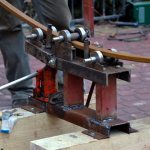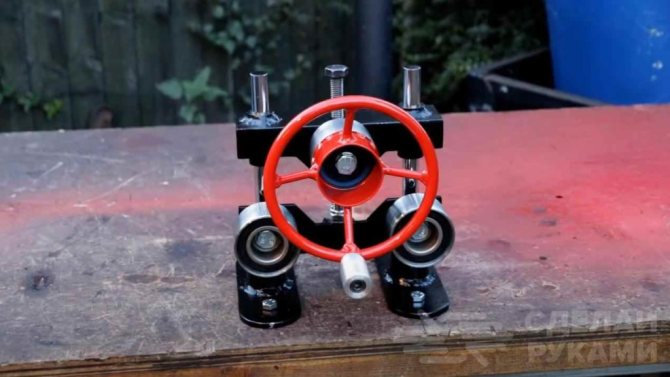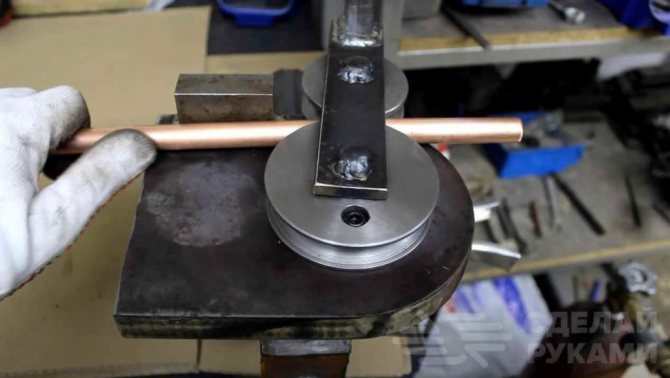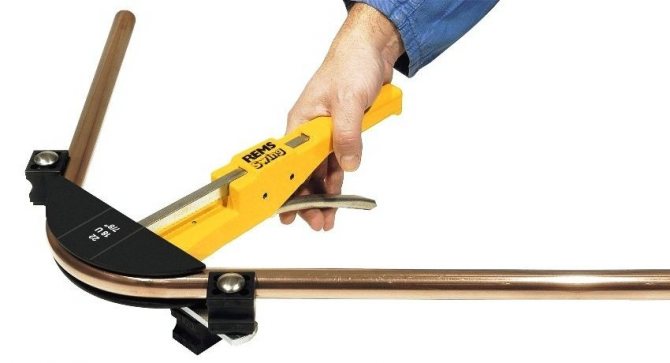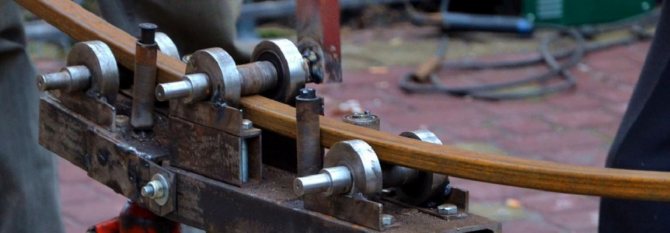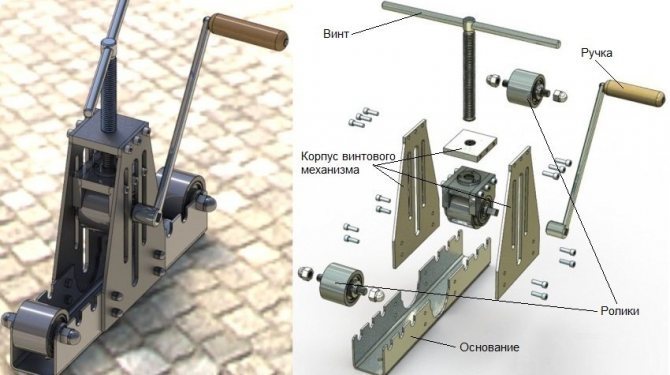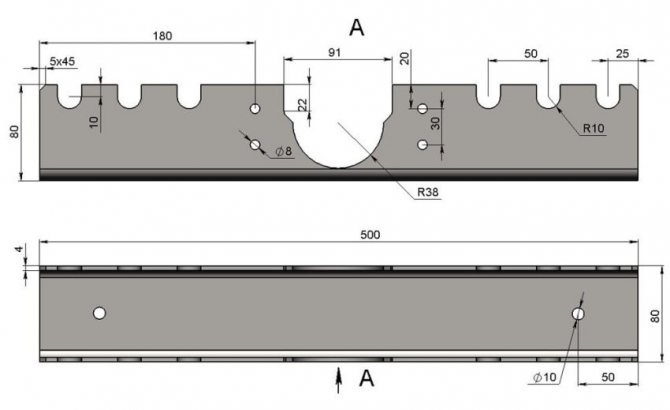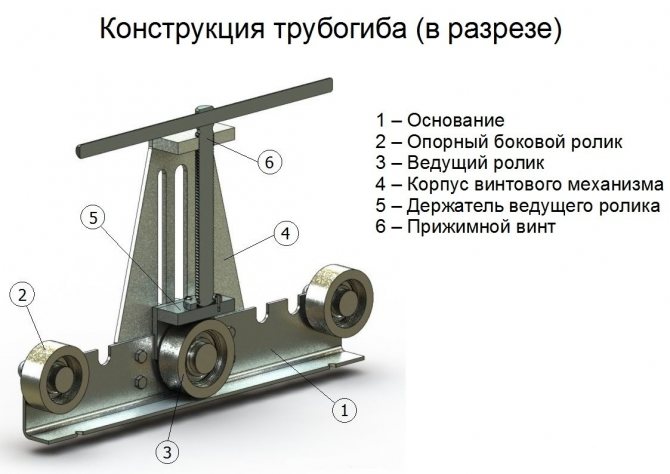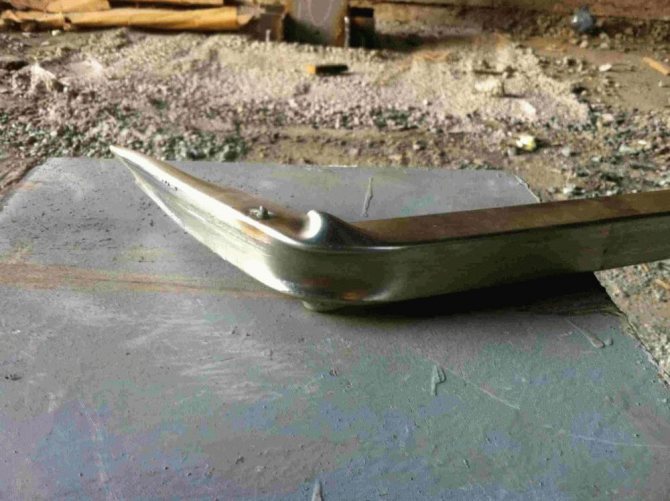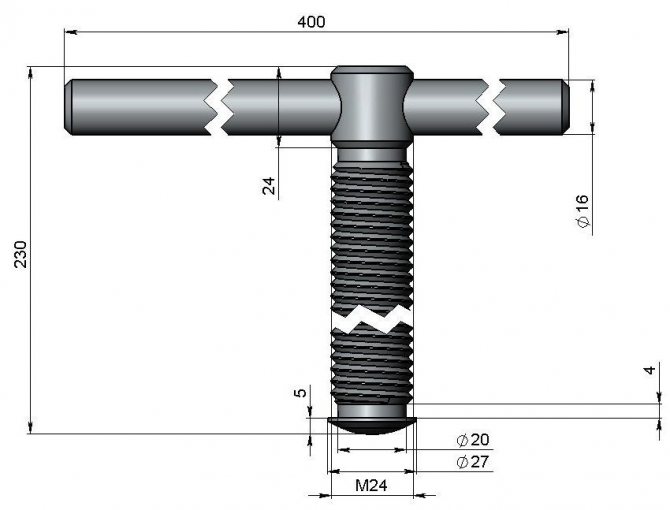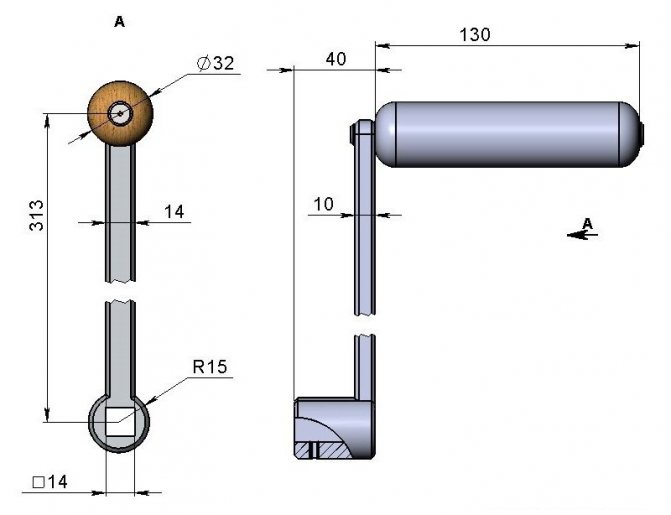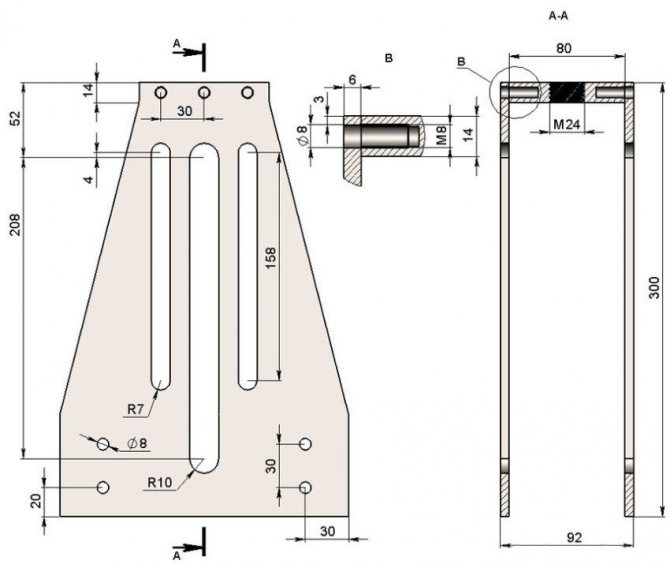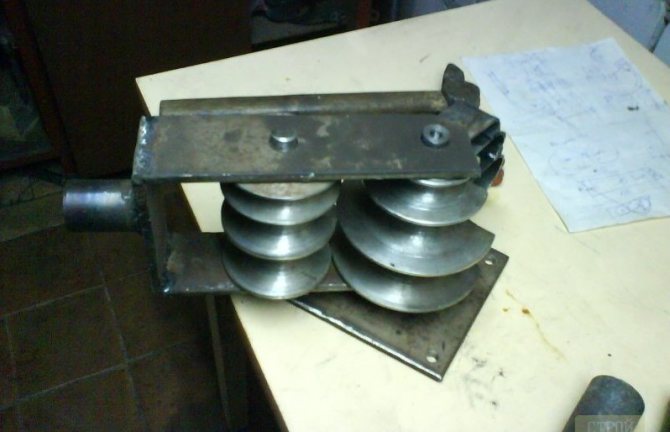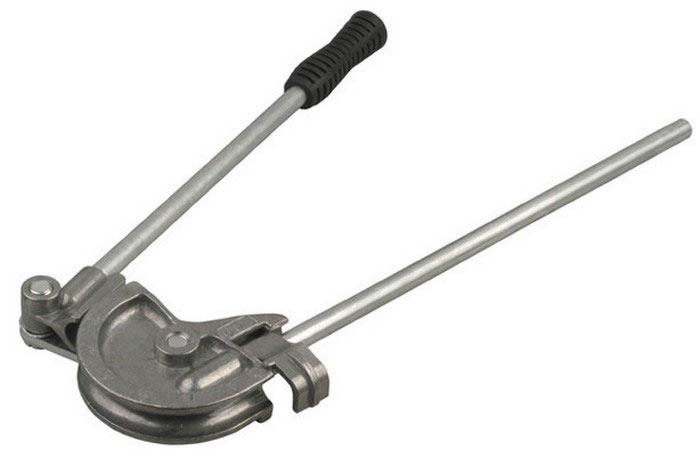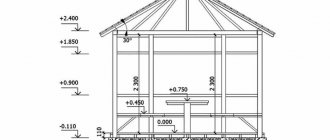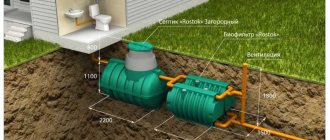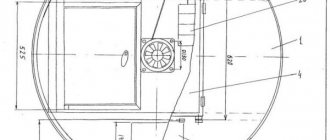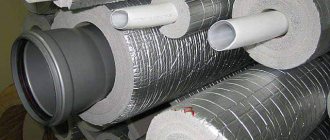The production of pipe benders in an industrial way is the release of two modifications of devices, where some are created in a mobile version, available for carrying, and others in a stationary one. Pipe benders connected to electricity are distinguished by great comfort of use. They provide the desired bend radius in accordance with a specific angle without deforming the profile.
If you are planning to carry out work on bending pipes at home, then certain nuances must be taken into account:
- the manual tool is equipped with a spring element, with the help of which the pipe configuration is changed;
- the segment tool makes it possible to bend the pipe by stretching it around the segment of the equipment used;
- the mandrel tool allows bending only thin-walled pipes to a rather small radius by means of special guides.
Basic information about pipe benders
Before starting a story about the options and methods for making pipe benders, you need to decide what it is and what it is used for. So a pipe bender is a manual device or a stationary machine that allows you to bend a pipe made of any material at an arbitrary angle.
The pipe can be steel, copper, aluminum or plastic with a diameter of 5 to 1220 mm or profile with any section. Bend angle from 0 to 180 degrees. This article brings to your attention the manufacturing technology of several types of this uncomplicated device, having studied which, in a few hours you can make any copy you like.
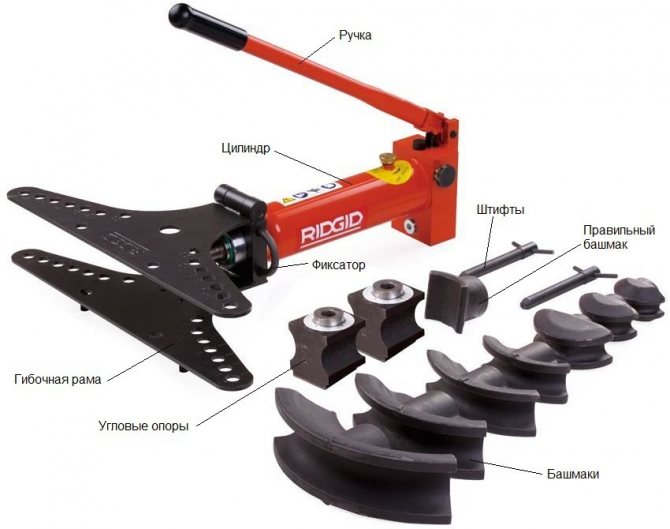
Pipe bender device with shoes for various pipe bending angles
What pipes can be bent?
There are no restrictions here if the right tool is chosen. You can get the desired shape of parts by using pipelines from:
- plastic;
- aluminum;
- become;
- metal-plastic;
- copper.

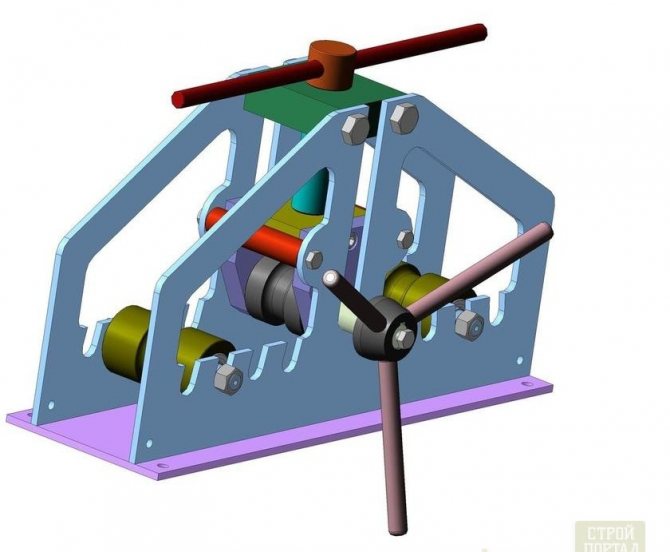
Important! The choice of a suitable pipe bending device is greatly influenced by the cross-section of the pipeline itself and its profile. For example, it is much easier to give the desired shape to ordinary round elements of the future system than to profile ones, preventing their deformation or even complete breakdown.

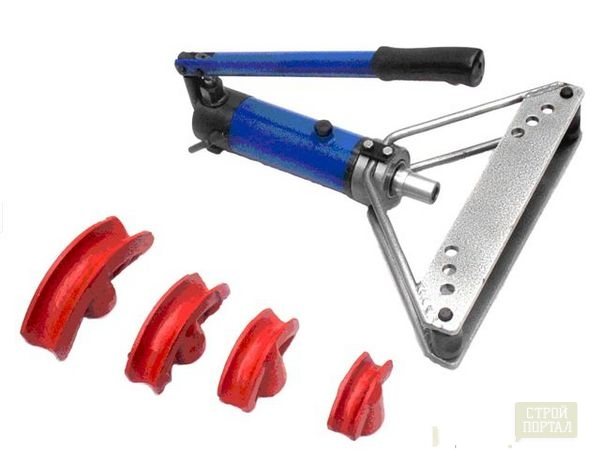
What are the types of pipe benders
If we are talking about industrial devices, then they are divided into several types according to the method of implementing the drive, as well as the type of bending.
Classification by drive type
There are machines: hydraulic, electromechanical and manual. Hydraulic-driven machines are manual and stationary. Their power is enough to bend pipes even 3-inch diameter. Hydraulic pipe benders are used in professional activities in specialized industries and are capable of performing a very large amount of work.
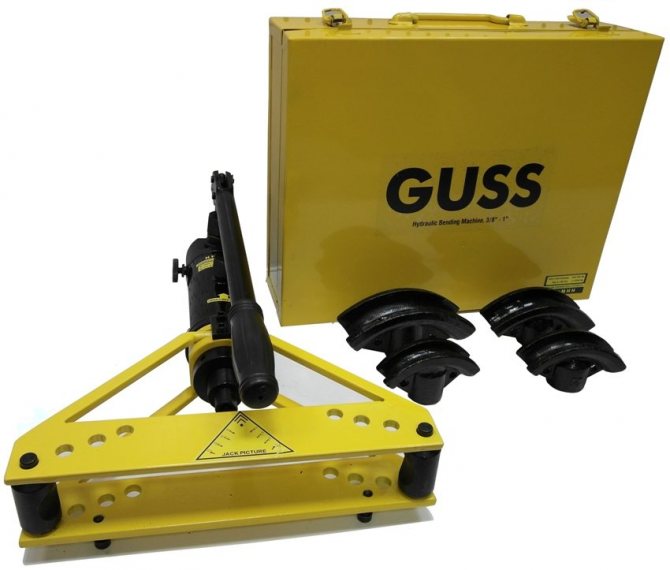

Hydraulic pipe bender for bending water and gas pipes up to 90 °
Electromechanical devices can be used to bend almost any pipe, even with very thin walls, which is beyond the power of hydraulics. After all, electronics allows you to very accurately calculate the force and bending angle, which prevents the material from breaking. Pipes bent by such devices do not show the slightest signs of deformation.
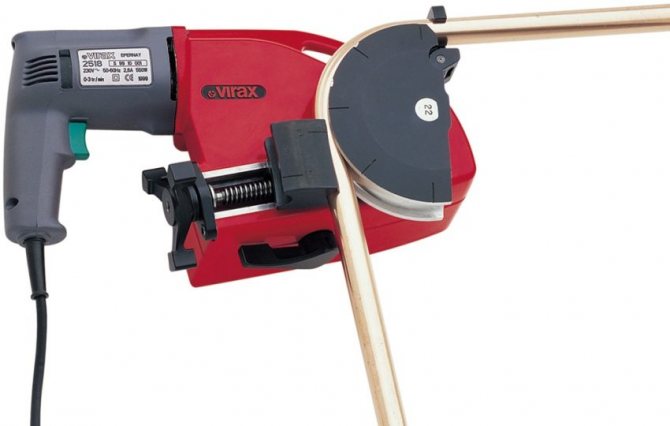

Electromechanical pipe bender for PEX / AL / PEX pipes and bending angles up to 180 °
Manual pipe benders are used only for bending small diameter pipes made of polymers, stainless steel or non-ferrous metals. They work mainly from the mains. They are easy to use and do not require a lot of physical strength to work. It is quite possible to make such pipe benders for a profile pipe with your own hands.
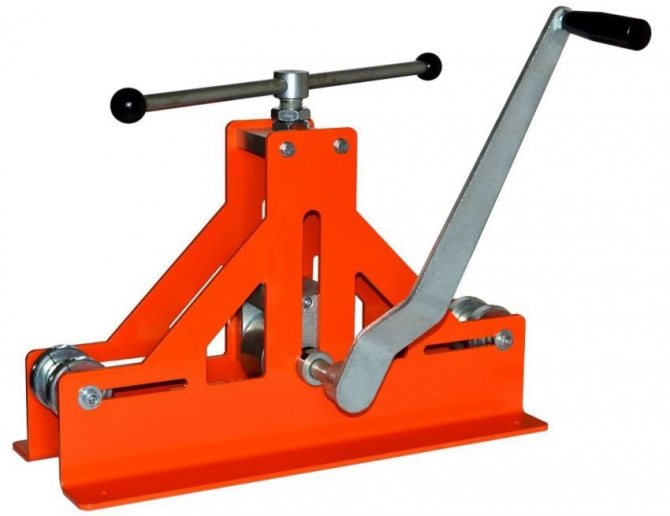

Hand tool for bending rectangular profiles and steel pipes
Classification by pipe bending method
You can bend a pipe using the device in various ways. Depending on this, the following types of pipe benders can be distinguished: crossbow, spring, segmental, mandrel.
Crossbow devices are equipped with a special shape, which is a bending element. It is designed for one pipe diameter or cross-section. To bend a pipe of a different diameter, the mold must be replaced. The spring devices are equipped with elastic springs that allow plastic pipes to be bent without deformation. Segmented ones are equipped with a special segment that pulls the pipe around itself, bending it at the desired angle.
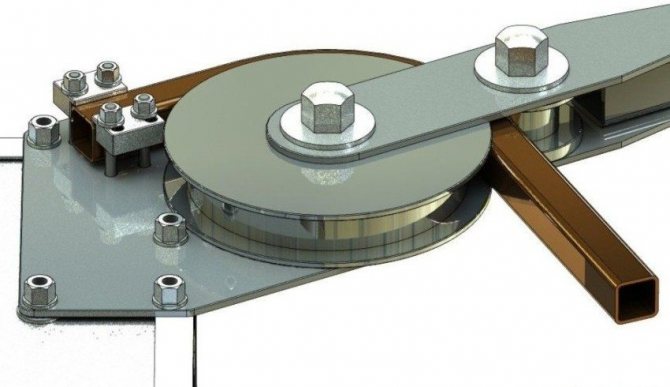

The principle of bending a profile pipe using a homemade tool
It should be understood that the method and value of the bending angle of the pipe depends on its characteristics. There is even such a value as the minimum bend radius, with a further decrease in which the pipe deforms or simply breaks. This indicator depends on the wall thickness, material and section of the pipe.


One of the options for using a bent profile is arranging a greenhouse
What materials and tools we need
Before proceeding to the manufacture of a pipe bending machine for shaped square pipes, we advise you to stock up on tools and materials. Otherwise, during work you will be distracted, as a result, the process will take you more time.
To make a roll forming machine, we need:
- for the base of a homemade profile bending - a channel or two welded corners, the thickness of the shelves is not more than 3 mm;
- high quality steel rollers, ideally hardened, they should not be smooth, there are small rollers on the edges.
These are the rest of any pipe bender. Depending on the model and type of device, a number of other elements may be needed.
Of the tools, you should have at hand - a grinder, a drill, a hammer, a wrench, which, as a rule, has a reliable and impressive base, and a welding inverter if you begin to weld the elements of the machine, and not sit the parts on bolts.
How to make the simplest manual pipe bender for a profile pipe with your own hands
Now let's look at some homemade pipe benders. The simplest option provides for the possibility of bending the pipe by means of a template to a given radius. This technology is also quite suitable for bending steel pipes, not just aluminum ones. The template is simply cut out of boards, the thickness of which is slightly greater than the diameter or section of the pipe that needs to be bent.
These boards are securely fastened to each other so that the pipe cannot jump out of them during the bending process. To form a gutter, the boards to be fastened are simply cut at a slope for a round pipe. Then, the finished wooden template is attached to a table or other similar base. Next to the template, a stop is attached to fix the pipe.
A do-it-yourself pipe bender for a profile pipe of this type is able to bend even thick-walled pipes if you use a winch.If the pipe is profiled, then the bevels are not made when cutting the boards. Instead, the pipe is secured with several stops.
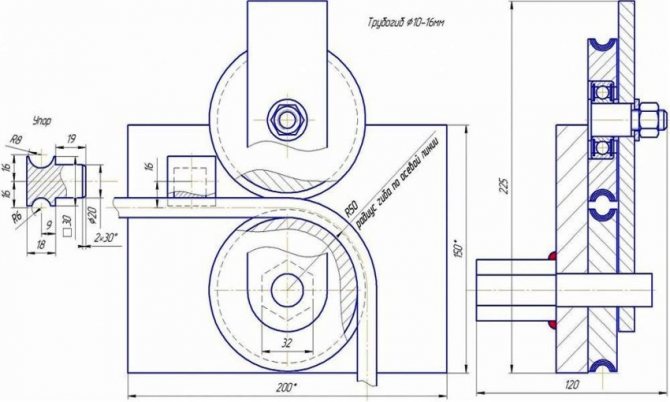

A drawing with dimensions for making a pipe bender with your own hands
Using wood, you can even build a rolling pipe bender if you grind wooden rollers. They can also be made from bearings or polyurethane. In general, the complexity of making homemade pipe benders in a certain way depends on the flexibility of the pipe. Compliant options can be bent on wooden fixtures without much difficulty just by hand, but for rigid pipes, more complex devices with metal parts will be needed.
Crossbow pipe benders
A do-it-yourself rod pipe bender, detailed drawings of which will be given below, can be done using both a hydraulic car jack and using a mechanical screw clamping system. In the first case, it will be possible to work with steel pipes of almost any diameter and wall thickness of more than 2 mm. In the second - with steel, copper and any pipes made of non-ferrous metals with a diameter of not more than 32 mm.
The jack can be installed with any carrying capacity - from 5 to 15 tons, as required by the intended type of activity and financial capabilities. Bottle jacks, with a lifting capacity of over 5 tons, are quite expensive, it is not economically feasible to buy them for use in a home workshop, where bending is done from time to time. But for a workshop or workshop - the more powerful the jack, the better. There will always be work for him, if not as part of a pipe bender, then under the car for sure.
The crossbow pipe bender is structurally limited by the bending angle - it can only bend the pipe up to an angle of 90 0. If a larger angle is required, then you can reach the workpiece using a lever or a winch, but in this case you will need a support punch or template made of metal or wood.
When bending thin-walled pipes, there is a risk of deformation of the inner sections of the walls. This threat can be eliminated by filling the pipe with dry fine sand and plugging the end holes. A similar technology is used in mandrel benders and in the manufacture of coils. Thick-walled pipes bend more easily, but here, too, support in the form of a template or a metal segment is necessary. The appearance of the crossbow pipe bender fully reveals the scheme of its action.
Industrial and homemade pipe benders of this type in the photo:
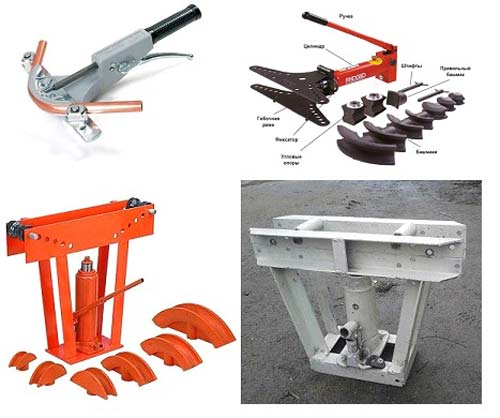

Industrial models of hydraulic pipe benders are equipped with a set of punches of various radii and groove widths. Replacing them at work is easy. They are made from strong tool steel and do not deform during bending, ensuring high radius accuracy.
You can buy factory-made punches in any size and for a homemade hydraulic pipe bender. Only when buying should not save. If you choose inexpensive Chinese tools, then you can get on rather fragile supports, which, when bending copper and colored pipes, are very good, but for steel, especially stainless steel, they are completely unsuitable.
In the role of a punch, you can use old pulleys cut in half along the diameter. Such an operation is quite laborious, but feasible even at home. You can find a pulley of a suitable diameter and groove width in markets, shops, the Internet, or even at scrap metal collection points. Their price, as a rule, is not very high and, in comparison with a jack, is even very acceptable.
Support rollers, as well as for rolling pipe benders, are both made independently and adapted ready-made. With the expected large amount of work, it is advisable to install them on bearings - rolling friction in this case will give a gain in operating speed.
Schematic diagram of a homemade pipe bender from a jack:
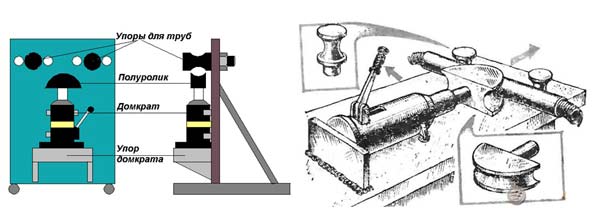

A working drawing can be made based on the following figure:
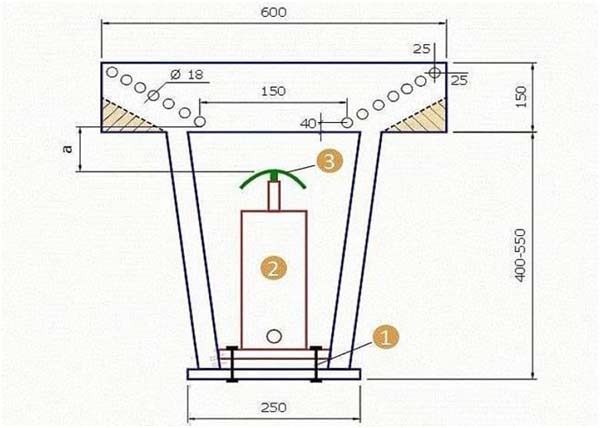

It should be noted that crossbow pipe benders can work both horizontally and vertically. But to convert the bending line to horizontal, standard car jacks need to be modified. The standard ones are for vertical use only and will not work even at an incline of over 450.
In tool stores, you can buy plumbing crossbow jacks for bending copper pipes and thin-walled steel pipes. They are designed for a horizontal position and in many cases can be operated with one hand. Many varieties of crossbow pipe benders are mechanically driven rather than hydraulically driven. When working with non-ferrous metals, the force on the rod is quite enough even for bending pipes up to 30 mm in diameter.
Making a homemade hydraulic pipe bender
If you decide to make a real hydraulic pipe bender, you need to get a hydraulic jack, channel, two rollers and a shoe. In addition, you will need several metal plates of steel over 3 mm thick.
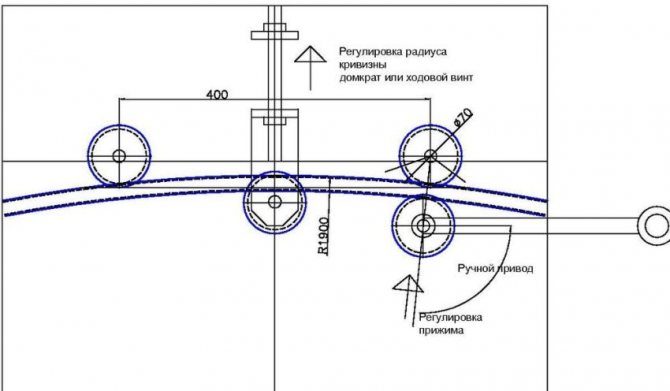

Scheme and principle of operation of a homemade hydraulic pipe bender using a jack
A rectangular structure is created from the channel using a welding machine, the height of which coincides with the height of the fully extended jack. It is installed on a rigid base and securely fixed with metal plates.
The jack must be selected with a lifting capacity of at least 5 tons. It is designed to act as a pusher. The main task here is to find the most suitable videos. The difficulty is that only with the most accurate rolls around the pipe can a really high-quality bend be obtained. If you find different rollers and make them removable, you can bend pipes of different cross-sections and diameters.
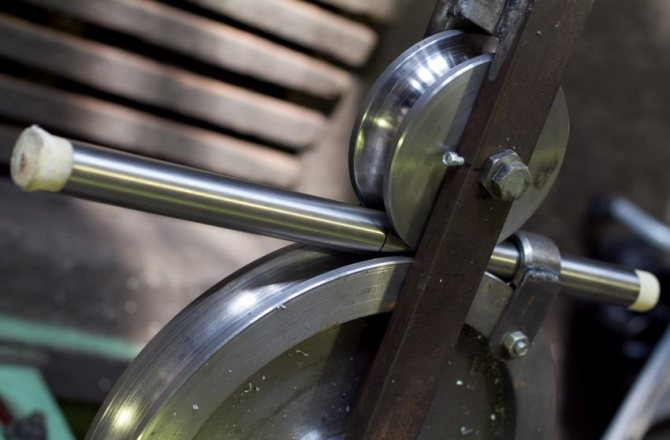

Example of a DIY bending device for metal pipes
The advantages of a hydraulic do-it-yourself pipe bender for a profile pipe are: ease of manufacture, availability and low cost of the jack and parts. Such a device allows you to bend any shaped and round pipes in a cold state with high quality.
Template type of machine
The simplest template type machine is often made from a soft material such as wood. When building such a machine, you need to understand that it will only be possible to work with thin-walled pipes on it. The diameter must be less than the thickness of the templatewhich is made of wood.
The tube bending tool must be secured to a secure and stable base. A square stop is attached to the left of the template. One end of the pipe is securely attached to the stop, and on the other side it is gently bent.
To simplify the design of such a machine, you can replace the wooden template with hooks. The hooks are made of metal and positioned along a given radius. The advantage of such a machine is that you can change the bend radius by simply twisting the hooks to another required radius. Thus, it turns out that the machine with hooks will be more flexible in work.
How to make a rolling pipe bender yourself
The pipe bending process in a rolling mill is as follows. The pipe is laid on side rollers, and a third one is lowered onto it from above, fixing the product in a given position. When we begin to rotate the handle, the chain drives the shafts in rotational motion, and the profile or round pipe is bent at the required angle.
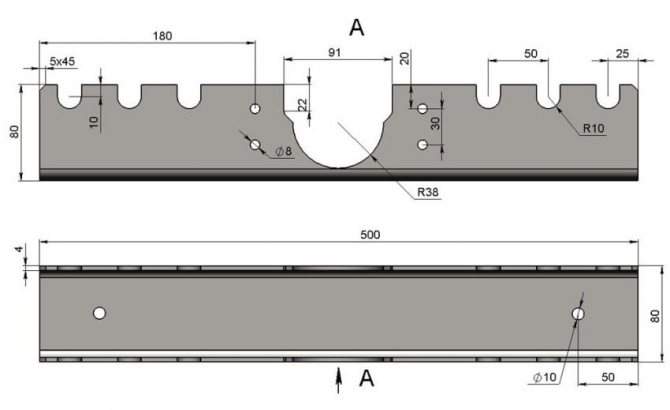

Step 1: creating the base of the pipe bender from a steel channel 80x80x4
To manufacture such a device, you must:
- grind rollers and bearing races. This task can be entrusted to a turner who, according to the drawings, will do the job in the best possible way. The device will have three shafts, one of which is suspended by springs, and the other two are fixed in the sides of the frame;
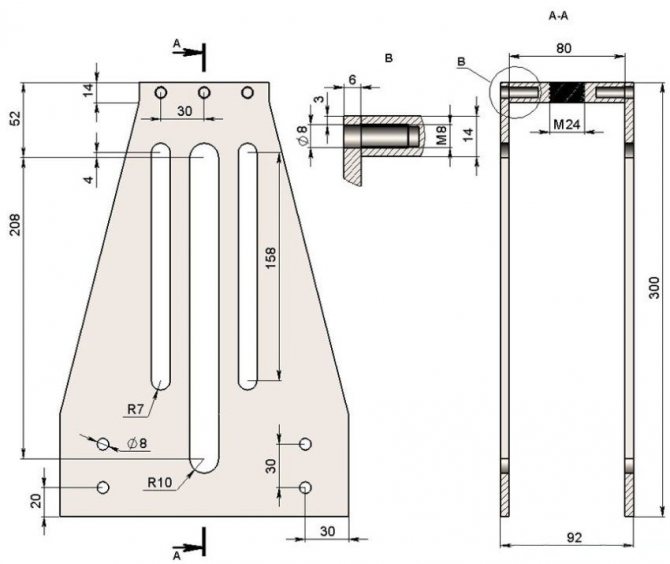

Step 2: making the screw housing
- prepare a shelf from a 50 mm channel. It looks like a rectangle with sides 100x30 cm. Holes are made in it for mounting the shafts and a thread is cut to adjust the position of the pressure shaft;
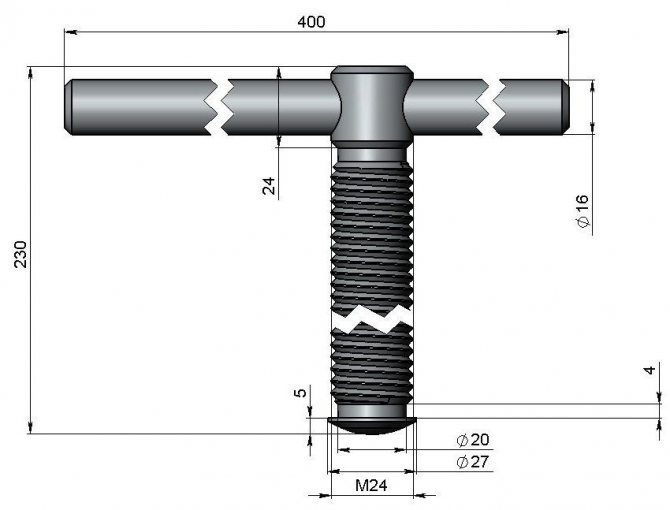

Step 3: create a standard threaded screw
- fasten all the parts together with a welding machine;
- the shelf with the pressure shaft is suspended on springs, and the side shafts are connected through sprockets with a chain. A handle for rotation is welded onto one of the shafts;
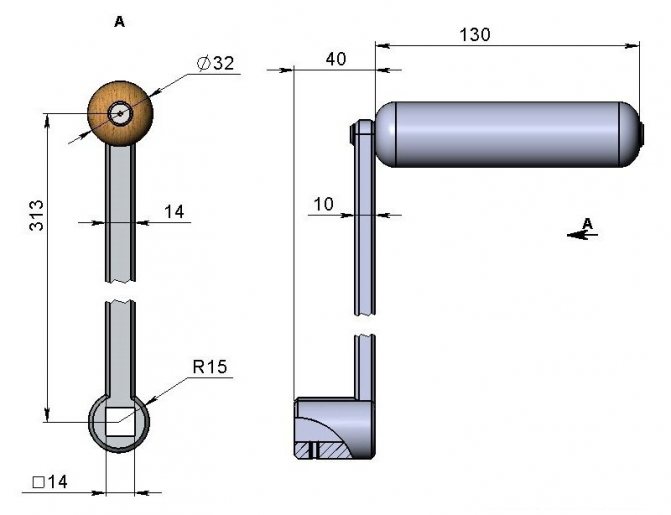

Step 4: making the center drive roller pivot handle
- mount the jack so that it can be used to easily adjust the downforce.
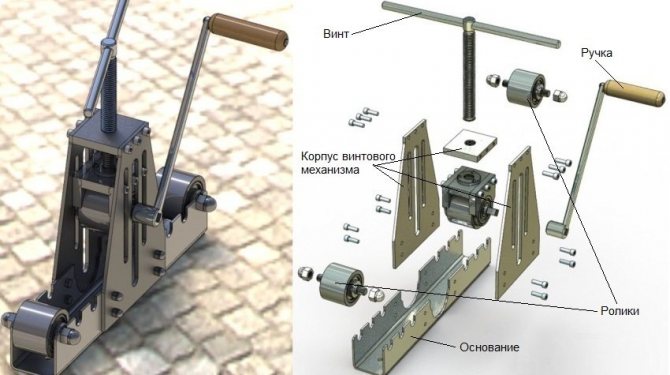

Step 5: assembling all the parts of the homemade rolling tube bender
A pipe bender for a profile pipe with your own hands can be made. Its complexity depends on the purpose for which you need it. If these are only one-time actions, then wooden structures are enough. If you are engaged in the manufacture of products from a pipe on an ongoing basis, then you will need a more complex unit.
Instructions on how to make a do-it-yourself profile bender
So, we turn to the manufacture of a pipe bender without turning. We decided to make two different models. You can familiarize yourself with both the video instruction and the text version of the step-by-step guide.
Manual tube bender
We need 8 pieces of bearings of 33 sizes, for the base a channel 40 by 80, a construction pin for 18, washers with a size of 18, a metal corner for 25, a piece of a rectangular plate.
Since we are making a manual pipe bender for a profile pipe for the first time with our own hands, we decided to prepare a drawing of our device - this will simplify the work.
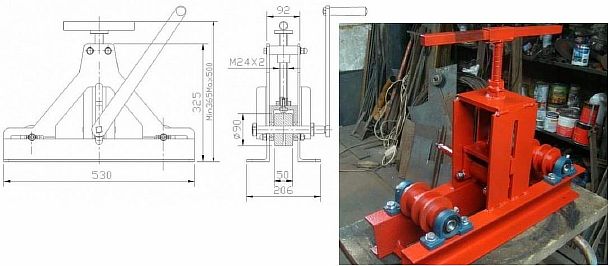

Drawing of the future pipe bender
After that, we have already started making the pipe bender itself:
- Saw off the channel of the required length and clean it from rust with a grinder.
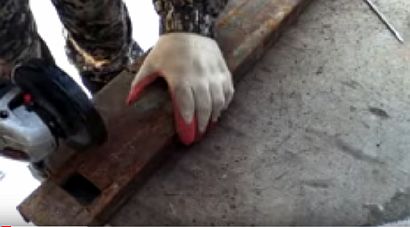

Cut the channel to size
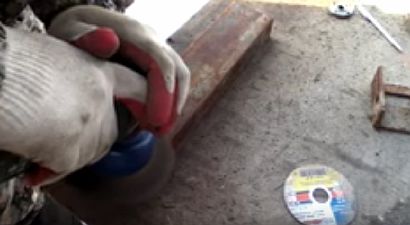

We clean up rust
- We clean the thread from the construction spire, also with a grinder. This is necessary for the free movement of the bearings along it.
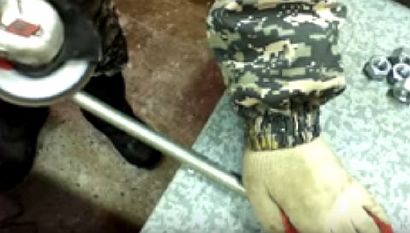

We clean the thread from the spire
- Preparing the washers - using a hammer, give the washer a slight cone shape. A washer of this shape will allow the bearing to move freely.
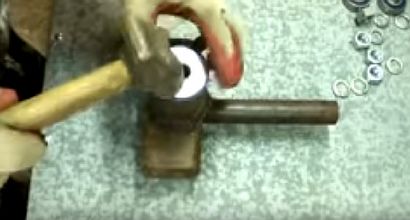

Bend the washer slightly
- We collect two rollers - on the hairpin along the edges we set the nuts to 18, in the middle there are 3 bearings. The slightly curved washers do not touch the edges of the bearings and they move freely.
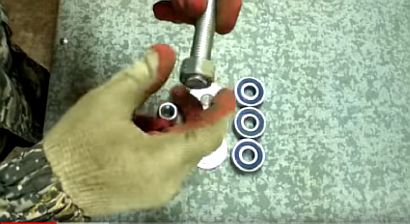

We put a nut on the hairpin
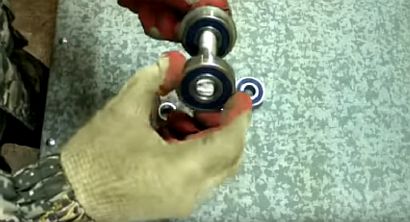

Putting on the washer and bearings
- We tighten the nuts with a wrench and cut off the excess studs.
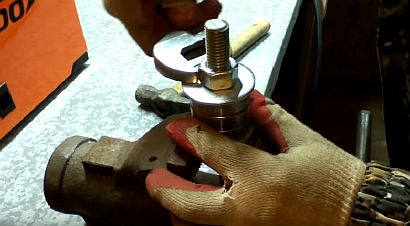

Tighten the nuts with a wrench
- We grab the edges by welding.
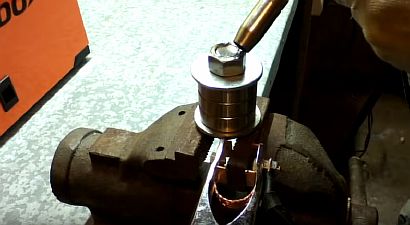

Weld the edges
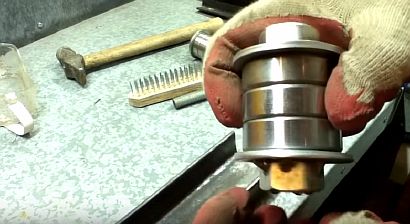

Finished video
- From a metal corner we cut off 4 blanks of 25 cm each. They will serve as guides for the rollers - the leading and the pressure rollers.
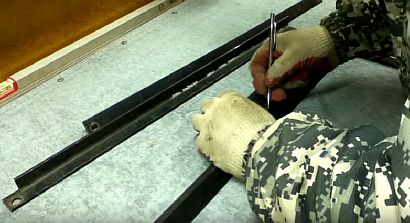

Measure the size of the guides
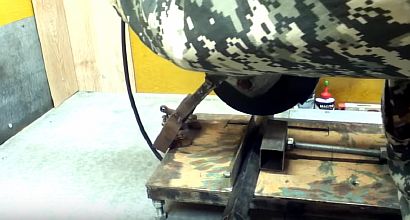

Cut out blanks
- We weld the corners to the channel. The distance between two adjacent blanks is determined by the size of the stud, it must pass freely into the gap.
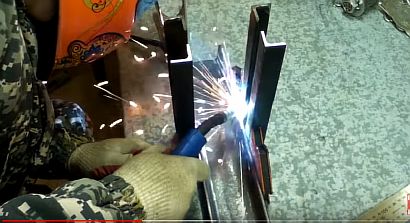

We weld corners with a channel
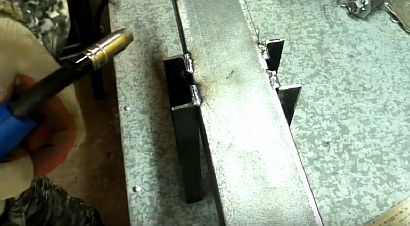

Weld from below
- We make a driving roller - we put on a piece of pipe with a diameter of 25 mm on a 18 pin. We fill the space between the pipe and the hairpin with carnations by 40, from which we first cut off the caps.
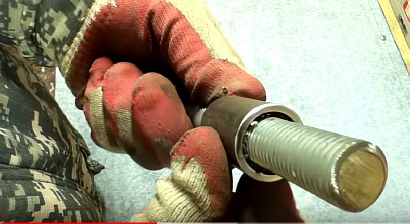

Making a lead video
- For the reliability of the structure, we also grasp the edges by welding, having previously clamped the workpiece in a vice.
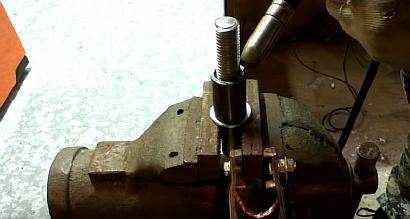

We scald the edges
- We put on the edges of the shaft 33 bearings.
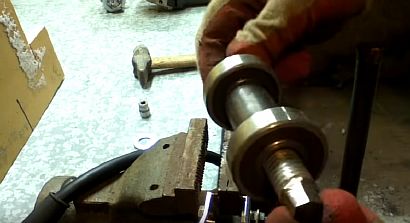

Putting on bearings
- We turn to the manufacture of a movable carriage. To do this, take two sections of a profile pipe 20 by 40, 30 mm long, and a rectangular metal plate 80 by 50 mm.
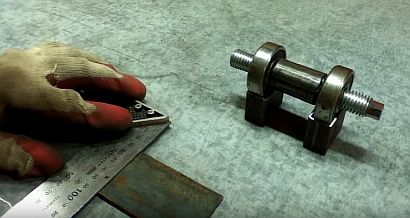

We prepare the carriage parts
- We weld the sections of the profile to the plate, and to it the drive rollers.
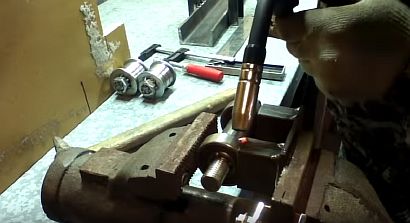

We weld all the elements
- At the bottom of the carriage, having determined its midpoint, we make a hole with a drill. Its size should match the diameter of the stud by 18.
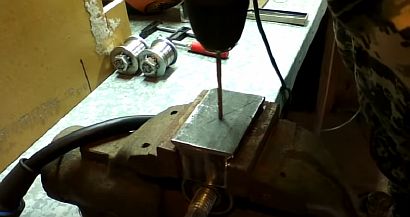

Making a hole from the bottom
- We start assembling the lifting mechanism. We need a hairpin and three nuts. A stud is inserted into the hole of the carriage, a nut is screwed onto it from the inside, which is seized by welding. Then, on the reverse side, we put on the second nut on the stud, which we also weld on.
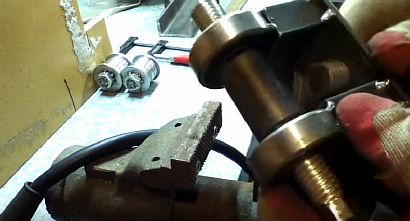

Insert the hairpin
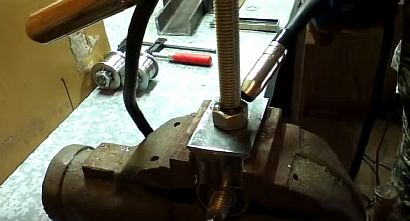

We dress and weld the nuts
- We cut off a workpiece from a rectangular metal plate measuring 70 by 13 - which will serve as a stop for the lifting mechanism.
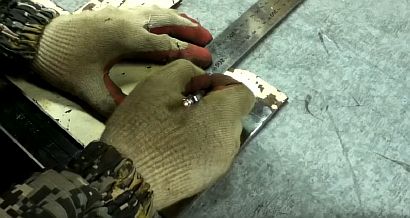

Cutting off the workpiece for the thrust mechanism
- We measure the middle in the workpiece, make a hole at 18.
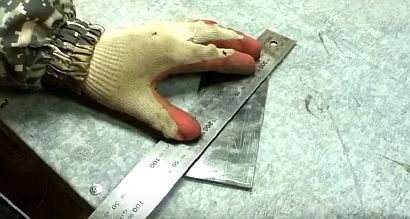

Measure the middle for the hole
- We start assembling the pipe bender. We install a carriage with a drive roller on the base from the channel. We put on the plate on top and tighten the nut, which we grab by welding.
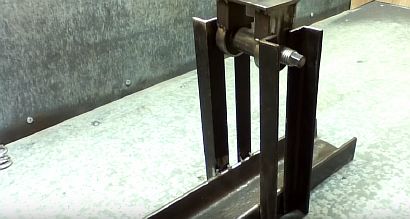

Installing the carriage
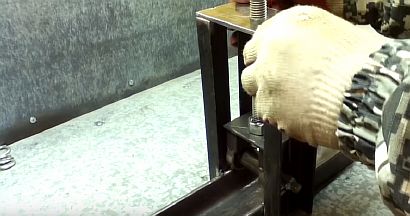

Place the plate
- We weld the rollers along the edges of the base, and the handle to the lifting mechanism.
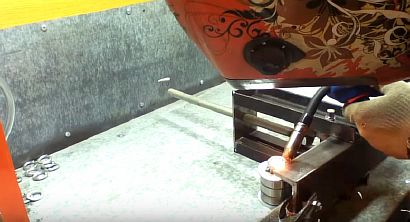

We weld the rollers
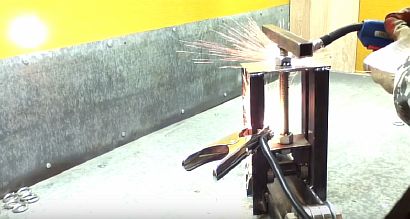

Welding the handle
- We make a manual drive - for this we take a profile 20 by 20, a handle from a drill, which we screw to the profile. We grab the pipe section by welding to the driving roller.
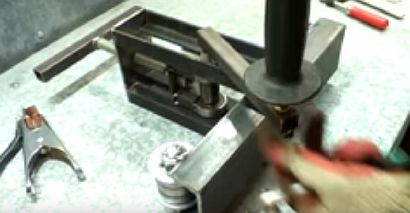

We attach a manual drive
The pipe bender for the profile pipe is ready, you can proceed to the test.
Hydraulic tube bender
We decided to try again to make a more powerful device powered by a hydraulic drive, as it turned out to be not so difficult to do.
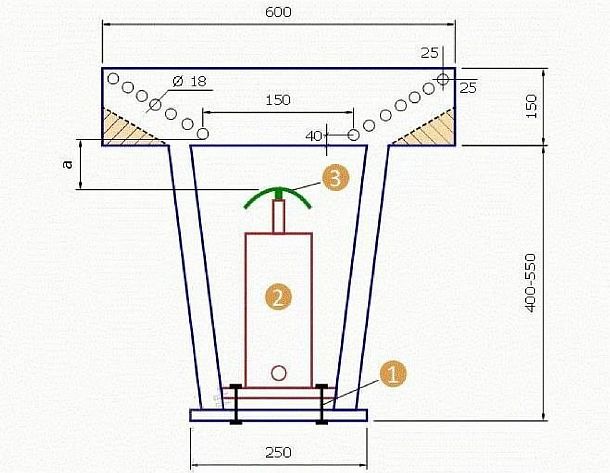

Hydraulic pipe bender drawing
- First, we prepared the bed, we built it from a channel, corners and a metal plate, by welding these elements together. We also need 2 rollers, a semicircular nozzle and a machine jack.
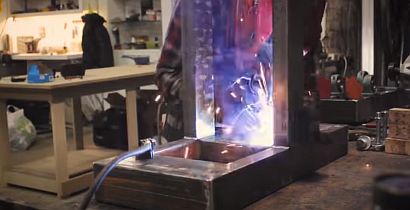

We weld the bed
- At the base of the bed, we make 6 adjustment holes on both sides, rollers will be fixed in them, depending on the required bending angle.
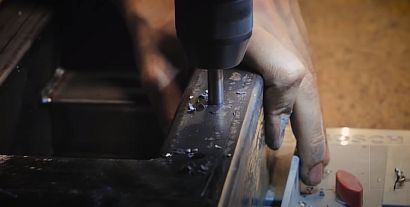

Making holes
- We install the rollers in the holes made in the bed.
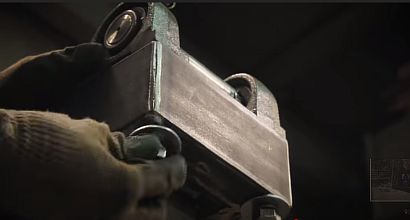

Place the rollers
- We put on a semicircular attachment on the stealthy mechanism, and place it under the rollers.
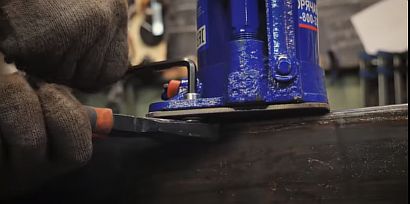

Install the jack
- The device is ready, insert the profile between the rollers and the jack. By lifting the mechanism, we bend the profile pipeline.
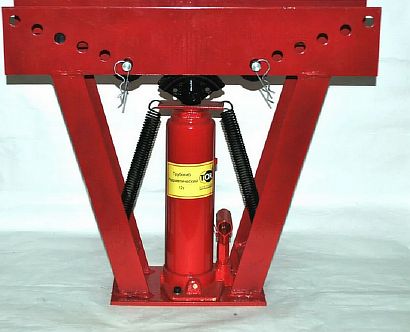

Hydraulic pipe bender
Materials for the manufacture of a pipe bender
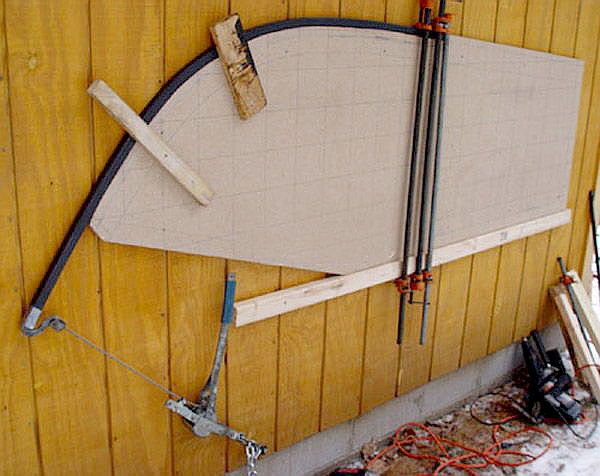

You can assemble the simplest pipe bender with your own hands from scrap materials that can be found both in private households and at their summer cottage. To assemble the product you will need:
- wooden shield (can be made from unnecessary boards);
- large hooks (a bendable pipe will be located in them);
- a pair of sturdy boards or two small beams.
On the prepared shield, you need to draw a semicircle along which you need to bend the pipe. If the product is versatile and is made for frequent use, several semicircles can be applied. Below, under the main semicircle, boards or timber are vertically positioned and nailed. They will help guide the pipe neatly and secure the ends while bending. Hooks are attached along the semicircle. Such a homemade pipe bender is optimal for the preparation of elements of heating and water supply systems. Its only inconvenience is the need to outweigh the hooks to obtain different bending angles on the pipes.

